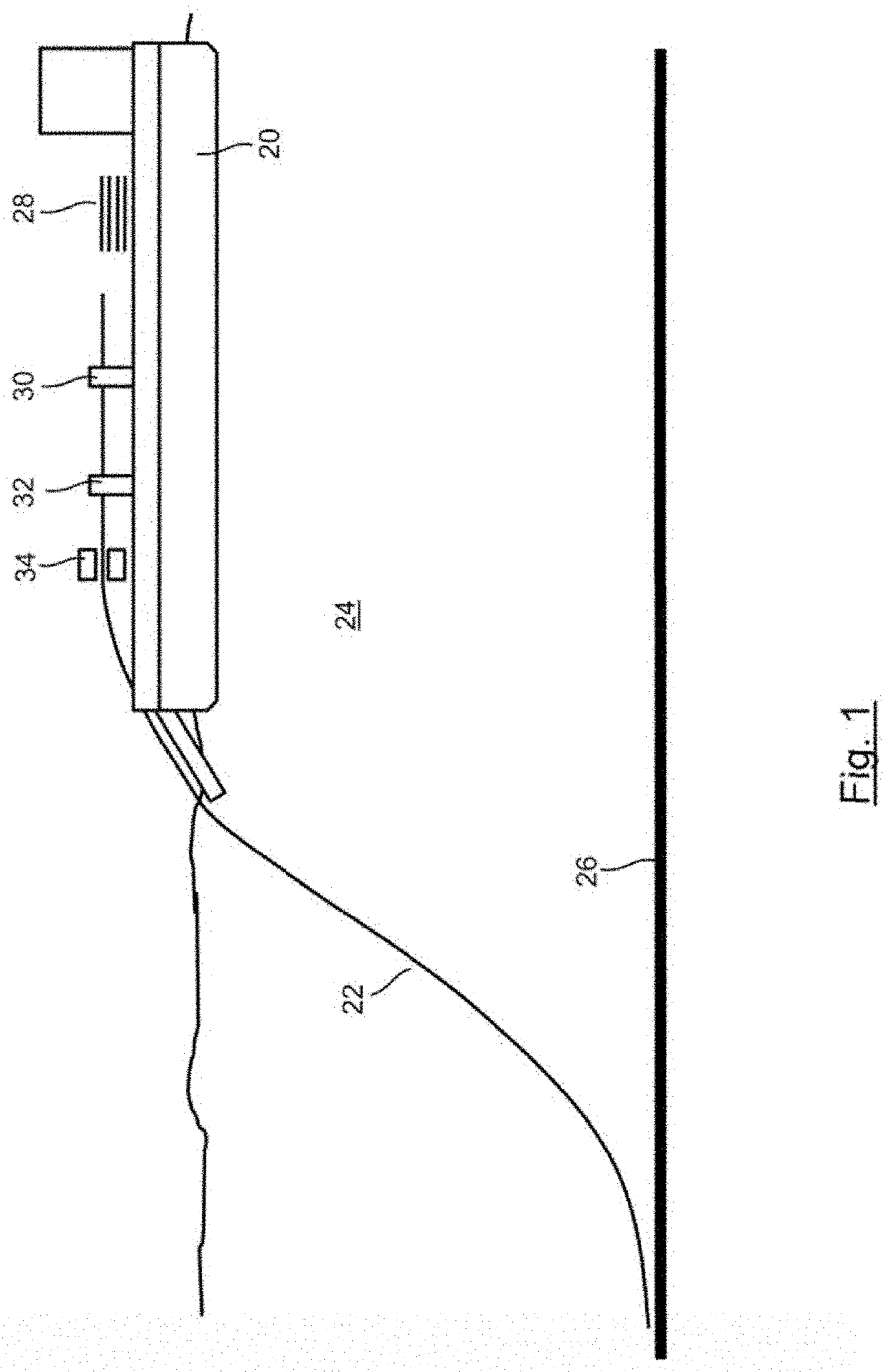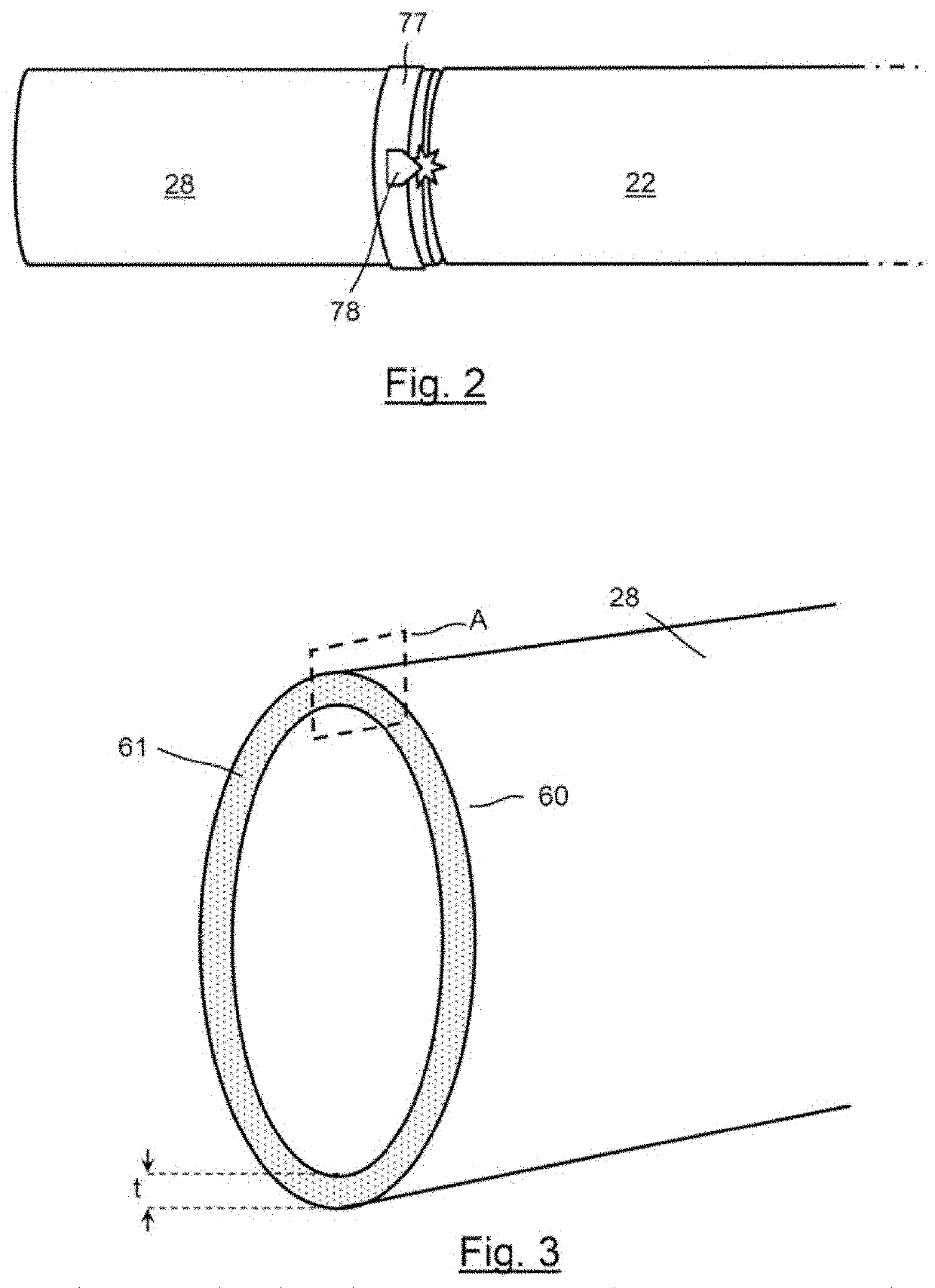Improvements in the welding of pipes
- Summary
- Abstract
- Description
- Claims
- Application Information
AI Technical Summary
Benefits of technology
Problems solved by technology
Method used
Image
Examples
first embodiment
[0079]FIG. 1 shows a pipe laying vessel 20 laying a pipeline 22 in water 24 using an S-lay process. It will be seen that the pipeline 22 forms the general shape of an “S” as it is laid off the vessel 20 towards the seabed 26. The first embodiment concerns welding successive sections 28 of pipe to the end of the pipeline 22 as the pipeline is laid from the vessel 20.
[0080]The sections 28 of pipe added to the pipeline 22 (string) are each 12 m long (but could be multiples of 12 m in other embodiments, or any other length). Each pipe has an outer diameter of 1000 mm. The sections 28 of pipe (and the resulting pipeline) are steel pipes having a relatively low carbon content. The steel is low carbon weldable grade steel having a relatively low effective carbon content (CE).
[0081]The alloying composition of the steel pipe in this embodiment (as ascertained using the ASTM E415-17 “standard test method for analysis of carbon and low-alloy steel by spark atomic emission spectrometry” made av...
third embodiment
[0098]the invention is illustrated by FIGS. 13 and 14. In this embodiment, the intermediate material 61 is deposited on the ends 60 of the pipes as a porous material having multiple voids formed therein. Such voids may comprise at least some that are in fluid communication with each other. Such voids may comprise at least some that are closed voids. In this embodiment of the invention, the coating of the pipes performed in a factory on land. The intermediate material 61 is deposited as a lattice-type material having voids 68 that collapse as the surrounding material deforms when the pipe ends are brought together. Such voids 68 are evenly distributed to ensure an even distribution of the filler material between the faces of the ends 60 of the pipes when fully brought together. This may assist in accommodating for misalignment in the axial and radial direction of the pipe end faces. Each of the voids may have a volume of between 0.001 mm3 and 1 mm3. There may therefore be thousands o...
fourth embodiment
[0099]FIG. 15 illustrated the invention, which incorporates the features of previous embodiments, except that the intermediate material is not coated on either of the ends 60 of the pipes. Instead, it is provided as a thin layered gasket 63 which in use is inserted between the pipes, mechanically by a device 64, as the two pipes are brought together. This has the benefit that the pipes do not have to be pre-coated before welding. The gasket 63 is made of material that is softer than the pipe material and is thus able to deform in the manner described above to reduce the effects of misalignment of the pipe end faces.
[0100]A fifth embodiment of the invention, not separately illustrated, incorporates the features of the first embodiment, except that the intermediate material is substantially entirely nickel (purity >99%), and is applied at a minimal thickness, 0.1 mm on one pipe end face only meaning that the total thickness of filler material sandwiched between the pipe end faces is 0...
PUM
| Property | Measurement | Unit |
|---|---|---|
| Length | aaaaa | aaaaa |
| Length | aaaaa | aaaaa |
| Fraction | aaaaa | aaaaa |
Abstract
Description
Claims
Application Information
 Login to View More
Login to View More - R&D
- Intellectual Property
- Life Sciences
- Materials
- Tech Scout
- Unparalleled Data Quality
- Higher Quality Content
- 60% Fewer Hallucinations
Browse by: Latest US Patents, China's latest patents, Technical Efficacy Thesaurus, Application Domain, Technology Topic, Popular Technical Reports.
© 2025 PatSnap. All rights reserved.Legal|Privacy policy|Modern Slavery Act Transparency Statement|Sitemap|About US| Contact US: help@patsnap.com



